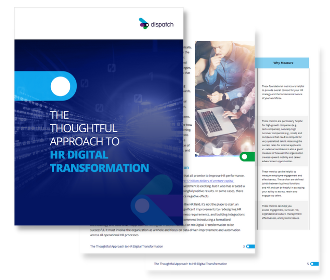Integrating Workday With Kronos For National Multi-Brand Retailer
Client
Nationwide Retail Distribution Operations
Challenge
Our client is a national multi-brand retailer that operates several large-scale logistics and distribution centers across the country. Accurate time management is a critical operational management requirement – especially given the organization has several collective bargaining agreements that must remain compliant. They asked Dispatch to implement a solution that would source time-off balances for their employees from their Human Capital Management system of record (Workday) and integrate this data with Kronos’ Workforce Suite. This needed to be a bi-directional integration that included processing the time & attendance data from Kronos to generate payroll in Workday.
This initiative was delivered in multiple phases, the first of which involved integrating Workday and Kronos’ legacy platform. After this integration became operational, our client upgraded to Kronos’ newest offering of their software, the Kronos Dimensions Workforce Suite.
With both the legacy system and the new Kronos Dimensions system, Kronos was established as the system of record for time and absence tracking. Employees and managers interacted directly with Kronos to track time and attendance. Our integration passed this information to Workday for payroll processing.

Solution
As Workday is the system of record for employee time-off balances and vacation hour accruals, we built an integration to transfer these balances to Kronos weekly to ensure they were accurate for each pay period.
We built this solution using Workday’s Enterprise Interface Builder (EIB) with a report data source and custom report transformation to output a Comma Separated Value (CSV) file. The output CSV file was encrypted and uploaded to an SFTP server that the Kronos system would then pick up for further processing.
The data transferred in this integration consisted of all employees under a specific cost center hierarchy, including unionized workers. Due to the complexities involved in payroll processing with multiple collective bargaining agreements and regional differences, Dispatch ensured that the integration was not a “black box” and incorporated logs and metadata files to help payroll troubleshoot and resolve issues if they occurred.
Once the business processes were stable, our client began the process of upgrading to Kronos Dimensions. We changed the data processing structure to create segregated subgroups based on locations instead of a single nationwide model during this upgrade. Changing to subgroups is highly recommended for companies with large scale operations spread across multiple locations because it mitigates risk in the event of disruptions to the payroll system.
We are currently engaged in a third phase of the project to enhance notifications, pay-code splitting, wage progressions, and vacation pay.
Time & Attendance and Payroll are Mission Critical
There are very few business processes as critical as payroll. Mistakes, errors, and delays are costly and can impact morale. These processes can also be very complicated, especially when accounting for the variables of different collective bargaining agreements, employment contracts, and employment standards in various jurisdictions.
For us, this means a comprehensive Discovery phase of any project involving time & attendance and payroll is vital to success. Analyzing and codifying all the business rules regarding payroll, vacation and holiday accruals, seniority and pay progressions, and other contractual and statutory requirements are mandatory. Assessing the completeness and the accuracy of this logic by all business stakeholders is essential before any coding begins. It’s not enough to document business logic – for each use-case, the project team needs to explicitly design validation methods to ensure every scenario can be thoroughly tested before moving to production.
Our client’s employee population included unionized, non-unionized, contractor, part-time, full-time, hourly, and salaried resources. Some types of employees required Wage Progression logic, where compensation can change between pay periods. We needed to include algorithms to account for vacation balance reductions as well. We devoted a substantial amount of time to flush out payroll logic with all Subject Matter Experts (SMEs) familiar with each employee type.
One of the crucial decisions with integrations between time & attendance systems like Kronos and HRIS systems like Workday is understanding which system should incorporate integration logic. This can depend on which application is defined as the system of truth for specific data types, each application’s capabilities, and the organization’s particular business requirements. In this case, it made sense to have Kronos incorporate a substantial amount of business logic and keep the Workday side of the integration as simple as possible. Some integration logic elements had to be built in Workday because the data for that logic simply didn’t exist in Kronos.
Data mapping between systems is also an essential part of this kind of project. In some instances, time codes weren’t able to be mapped one-to-one between systems. In these cases, we needed to create transform logic in Workday so that General Ledger entries would be accurate.
Regardless of how comprehensive the integration is, there are always edge-cases and scenarios where manual intervention is required. It is critically important to consider how manual over-rides to the integration logic should occur. Unless adequate exception handling is built-in, errors caused by manual data entry could cause an entire payroll file to be rejected. We always include logic to ensure payroll files can be processed even if some of the data is faulty. We incorporate automatic alerting in these cases to ensure incorrect data can be identified and fixed quickly.
Because collective bargaining agreements and employment contracts change frequently, integrations need to be designed to be configurable by business users so that contract attributes can be adjusted directly without requiring changes in the code.
At the same time, we highly recommend rigorous test & validation processes, including comprehensive regression testing whenever changes are made to integrations. Regression testing is essential to ensure changes in one part of the integration doesn’t inadvertently change other aspects of the integration.
CASE STUDIES





